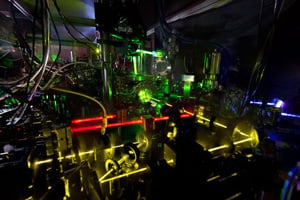
(N. Phillips/NIST)
Aside from the traditional ballad “Auld Lang Syne,” the 10-second countdown might be the most iconic aspect of New Year's Eve. On December 31, 2016, metrologists around the world—especially those living under Greenwich Mean Time (GMT)— will add a single second to their New Year's Eve countdown. International timekeepers have decreed, after some debate, that the atomic clock is due a leap second.
How we measure time
These scientists depend on the accuracy of our International System (SI) unit for the second based on the alkali metal cesium (Cs) element. The cesium atom has a resonant frequency that's very, very stable over time. When moving up and down in an oscillator—also known as the atomic clock—the atom produces a time measurement that is accurate, give or take a couple nanoseconds. This margin of error comes out to around one second every 1.4 million years.
According to Jeff Gust, Chief Metrologist for Fluke Calibration, this reproducible degree of accuracy demonstrates the importance of metrology, and its impact on our day-to-day lives. Take the example of taxis or rideshares that charge based on time and distance. The accuracy of meters and GPS affect how much you pay.
Approximately 200 atomic clocks around the world are averaged together to make the most accurate representation of International Atomic Time (TAI). However, when you check current time on your computer, you're seeing Coordinate Universal Time (UTC). Using a GPS disciplined oscillator, such as the Fluke 910 or 910R, which house rubidium-based atomic clocks, we can continuously measure the signal.
The leap second's importance
Leap seconds are added to keep international time in sync with solar time. Since 1972, there have been 36 seconds altered between TAI and UTC, all due to Earth's slowing rotation. We need these UTC adjustments so that scientists, astronomers, and astronauts can stay in sync.
What does this mean for you? If you live in the United States, the leap second won't be as dramatic, since it will go into effect in the afternoon (around 4 p.m. PST, 7 p.m. EST). However, if you find yourself celebrating in Greenwich, England, or a select few countries in Europe this New Year's Eve, it is technically correct to add an extra second to your final countdown.
Learn more about metrology and calibration at the flukecal.com Education Hub.